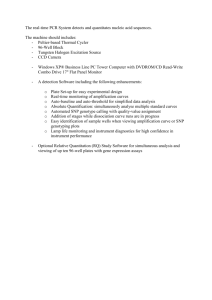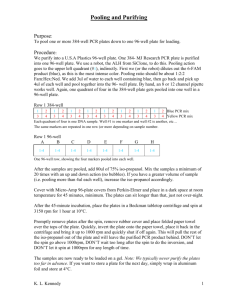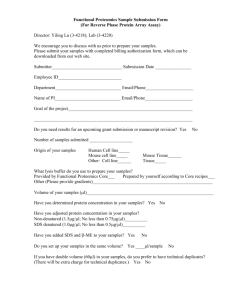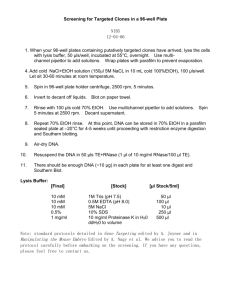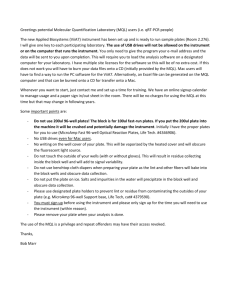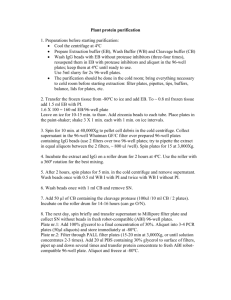TransAM transcription factor ELISAs
advertisement
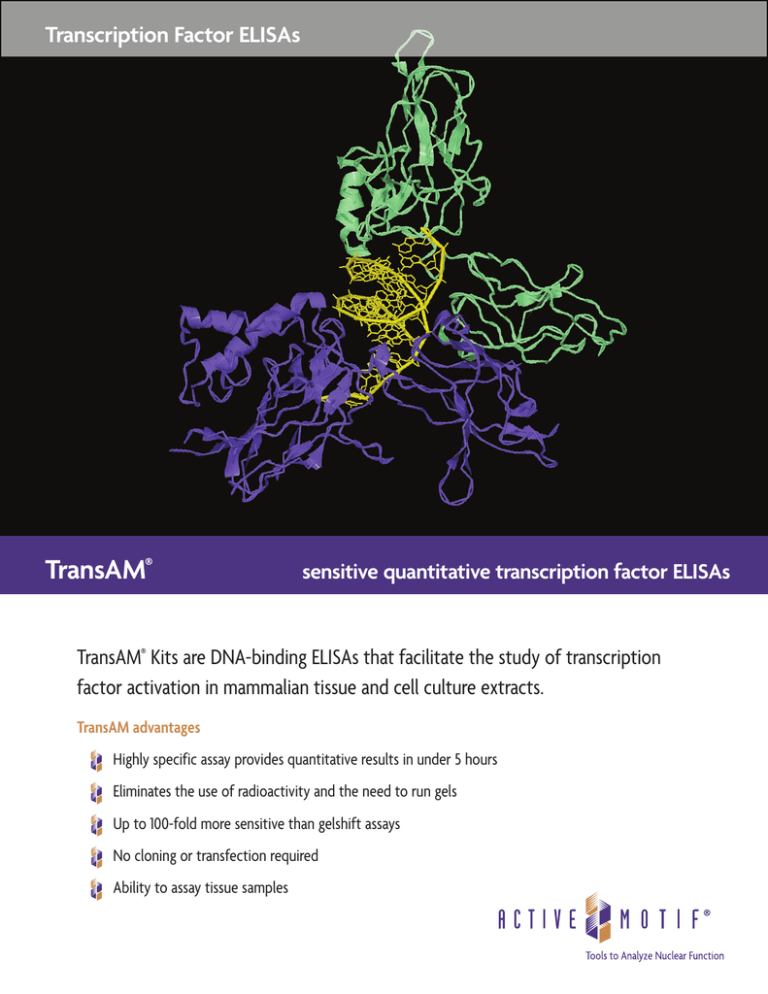
Transcription Factor ELISAs
TransAM®
sensitive quantitative transcription factor ELISAs
TransAM® Kits are DNA-binding ELISAs that facilitate the study of transcription
factor activation in mammalian tissue and cell culture extracts.
TransAM advantages
Highly specific assay provides quantitative results in under 5 hours
Eliminates the use of radioactivity and the need to run gels
Up to 100-fold more sensitive than gelshift assays
No cloning or transfection required
Ability to assay tissue samples
TransAM® – sensitive, non-radioactive transcription factor ELISAs
TransAM® Kits are DNA-binding ELISAs* that facilitate the study of transcription factor activation in mammalian
tissue and cell culture extracts. The novel TransAM method is up to 100-fold more sensitive than gelshift and is
complete in less than 5 hours. TransAM Kits eliminate the use of radioactivity and the need to run gels, while the
high-throughput format enables simultaneous screening of 1 to 96 samples in a single experiment. And unlike reporter assays, TransAM can be used on all sample types, including cell lines and tissues, giving you unsurpassed flexibility.
The study of transcription factors
TransAM® advantages
Understanding and quantifying transcription
factors is integral to the study of cellular
function in relation to differentiation, brain
activity, immune response, inflammation,
cancer, and much more. Families of closely
related homo- and heterodimer complexes
that bind to DNA (transcription factors) regulate many of the global signaling pathways
and are widely studied as disease targets.
TransAM Kits are highly sensitive DNAbinding ELISAs capable of detecting small
changes in transcription factor levels without
the need for gels or radioactivity. TransAM
offers the convenience of a fast, quantitative
and highly specific assay, making it the most
published alternative to EMSA (Figure 2).
Traditionally, transcription factors have been
studied using four methods: gelshift, supershift/Electrophoretic Mobility Shift Assays
(EMSA), immunoblotting and reporter gene
assays. These methods are time-consuming
and at best provide only semi-quantitative
results. Moreover, they don’t support highthroughput methods and tend to lack both
sensitivity and reproducibility.
• Quantitative – obtain quantitative
results in less than 5 hours
The TransAM method
®
Each TransAM Kit includes a 96-stripwell
plate in which multiple copies of a specific
double-stranded oligonucleotide have been
immobilized. When nuclear or whole-cell
extract is added, the transcription factor
of interest binds the oligonucleotide at its
consensus binding site. A primary antibody
directed against the transcription factor of
Add nuclear
extract
Add primary
antibody
1 hr.
• Sensitive – 100-fold more sensitive than
a gelshift assay
interest is added, followed by a secondary
HRP-conjugated antibody and HRP substrate (Figure 1). The colorimetric change is
measured with a spectrophotometer and is
directly proportional to the quantity of transcription factor present, providing a sensitive,
quantitative assay for transcription factor
activation.
1 hr.
Add anti-IgG
HRP conjugate
1 hr.
Add developing
and stop solution
• Non-radioactive – colorimetric and
chemiluminescent formats available
• Controls ensure success – includes
positive control extract and competitive
oligonucleotides
• Versatile – over 40 different transcription factor targets
('''
/''
-''
+''
)''
'
Cell extract
containing activated
transcription factor
Figure 1: Flow chart of the TransAM procedure.
Oligonucleotide
coated plate
(Flexi Kits enable any
oligo to be coated)
Figure 2: TransAM Kit citations.
Using HighWire Press, http://highwire.standford.edu,
a comparison of citations for TransAM from Active
Motif versus the tradenames of all competitor kits
combined was run. TransAM is clearly the leader.
* TransAM is licensed from EAT under issued and pending worldwide patents. Purchase includes the
right to use for basic research only. Other-use licenses available, please contact Technical Services.
The use of TransAM in NFkB-related drug discovery may be covered under U.S. Patent No. 6,150,090
and require a license from Ariad Pharmaceuticals (Cambridge, MA, USA).
www.activemotif.com
Sensitive – for improved transcription factor monitoring
2.5
NFkB activation (OD450 nm)
Small changes in transcription factor levels
can have a significant impact on cellular
function. Therefore, it is vital to use a sensitive assay when studying transcription factor
activation. TransAM Kits are 10-fold more
sensitive than gelshift assays (Figure 3). And,
TransAM Chemi Kits are even better, with
more than 100-fold increased sensitivity as
compared to gelshift assays. Not only does
this enable you to monitor small changes in
activated transcription factor levels, but you
can subtract the level of endogenous factor
present in your untreated samples, further
improving your results.
Unstimulated
IL-1a stimulated
2
IL-1a stimulated
0.5
1.5
1
5
10
Unstimulated
25
50
0.5
1
5
10
25
50
1
0.5
0
A
0.5
1
2
5
10 25
Cell extract/well (μg)
50
μg of cell extract
B
Figure 3: TransAM NFkB is more sensitive than gelshift.
Human fibroblast WI-38 cells are stimulated with IL-1a for 30 minutes. Increasing amounts of whole-cell extract are
assayed using the TransAM NFkB p50 Kit (A) or gel retardation (B).
Fast, quantitative results
Easy and safe – non-radioactive, colorimetric assay
Western blotting and reporter assays commonly require long incubation periods
either following electrophoresis or DNA
transfection, which can be frustrating and
inconvenient to perform. With TransAM
Kits you can go from sample to quantitative
results in under 5 hours. Why waste time
waiting when you can have your results in
the same day?
Gelshift/EMSA assays utilize the DNA binding capability of transcription factors to bind
to radiolabeled oligonucleotide probes prior
to electrophoresis. This can be time consuming and hazardous work to perform. While
TransAM Kits also utilize the DNA binding
properties of transcription factors, unlike traditional methods, they detect activated pro-
tein using antibodies rather than radioactivity.
This means that you can safely assay for a
specific transcription factor without the need
for radioactivity or the hassle of running gels.
The colorimetric change is easily measured
using a spectrophotometer, further improving
the ease of using TransAM Kits.
0.4
0.3
NFkB activation (OD450 nm)
To accurately study transcription factor
activation, it is vital to be able to determine
which isoform of the transcription factor
of interest is involved in pathway regulation. TransAM Kits are tested for specificity
by assaying in the presence of an excess of
oligonucleotide containing a wild-type or
mutated consensus binding site (Figure 4).
This competitive assay proves that the transcription factor detected is binding specifically to the probe that has been immobilized
to the TransAM plate. Our antibodies are also
assayed for cross-reactivity with other closely related family members to ensure that you
are detecting the isoform of interest. With
TransAM Kits you are guaranteed to detect
only the transcription factor that you want.
NFkB activation (OD450 nm)
Proven specificity – for improved accuracy
Unstimulated
IL-1a stimulated
0.2
0.1
0
A
No probe
1X
5X
20X
Wild-type probe excess
1X
5X
20X
Mutated probe excess
1
0.75
0.5
Wild-type
probe
Mutated
probe
0.25
0
B
Unst.
10 min 30 min 2 hr
AP-1 family members
Figure 4: Specificity of TransAM Kits.
TransAM NFkB p50 assays are performed in the presence of wild-type and mutated competitor oligonucleotides
using 10 μg/well whole-cell extract from human fibroblast WI-38 cells stimulated with IL-1a for 30 minutes (A) and
5 μg/well whole-cell extract from HeLa cells stimulated with TNF-a for 10 and 30 minutes, and 2 hours (B).
North America 877 222 9543 Europe +32 (0)2 653 0001 Japan +81 (0)3 5225 3638
TransAM® – sensitive, non-radioactive transcription factor ELISAs
Transcription factor families consist of various groups of homo- and heterodimer subunits that are differentially regulated within
the cell. Therefore, being able to profile
which members of a transcription factor
family are involved in cell regulation can help
identify potential disease targets. However,
profiling an entire transcription factor family
using gelshift, Westerns or reporter assays
is time consuming and expensive. TransAM
Family Kits enable you to profile activation of
various transcription factor family members
in less than 5 hours using one simple kit. The
TransAM NFkB Family Kit includes antibodies
specific for detection of activated p65, p50,
p52, c-Rel and RelB (Figure 5). The TransAM
AP-1 Family Kit includes antibodies specific
for active c-Fos, FosB, Fra-1, c-Jun, JunB and
JunD. The TransAM STAT Family Kit detects
phosphorylated STAT1a, STAT3, STAT5A
and STAT5B. The TransAM GATA Family Kit
detects GATA-1, GATA-2 and GATA-3. For
details, please visit our website at
www.activemotif.com/transam.
NFkB activation (OD450 nm)
TransAM® Family Kits – NFkB, AP-1, STAT & GATA
2
HeLa
HeLa (TNF-a)
Jurkat
Jurkat (TPA + CI)
Raji
1.5
1
0.5
0
p65
p50
c-Rel
p52
NFkB family members
RelB
Figure 5: Profiling NFkB family DNA binding activation.
Nuclear extracts prepared using the Nuclear Extract Kit
from HeLa cells, HeLa cells treated with TNF-a, Jurkat
cells, Jurkat cells treated with TPA + calcium ionophore
and Raji cells were assayed at 10 μg/well using the
TransAM NFkB Family Kit.
TransAM® Multiple-oligo Family Kits – MAPK & HNF
c-Myc, MEF2 and STAT1a. By immobilizing a
mixture of binding sites, each well in these
kits can be used to assay any family member.
HNF activation (OD450 nm)
Some transcription families have members
that do not share a single consensus-binding
site, making EMSA and reporter assays difficult. To overcome this, Active Motif has
developed TransAM Family Kits that have
multiple binding sites in each well. TransAM
HNF Family Kits contain a mixture of oligonucleotides with the HNF-1, -3 and -4 binding sites. HNF dimers contained in nuclear
extracts bind specifically to these oligonucleotides and are detected using antibodies
against HNF-1, -3a, -3b and -4a (Figure 6).
Similarly, the TransAM MAPK Family Kit contains a mixture of oligos and antibodies that
enable detection of activated ATF-2, c-Jun,
Extract
Extract with wild-type
competitor oligos
Extract with mutant
competitor oligos
2.5
2
1.5
1
0.5
0
HNF-1
HNF-3a
HNF-3b
HNF family members
HNF-4a
Figure 6: Specific assay for HNF family members.
Nuclear extracts from unstimulated Hep G2 cells were
assayed at 5 μg/well using the TransAM HNF Family Kit
in the absence or presence of 20 pmol of a mixture of
competitor oligonucleotides.
TransAM® Chemi Kits
Researchers who require maximum sensitivity
or with a limited amount of sample will love
TransAM Chemi Kits. With chemiluminescent
detection, transcription factor activation
can be assayed using as little as 40 ng of
cell extract (Figure 7). This makes TransAM
Chemi Kits over 100-fold more sensitive
than gelshift assays. Plus, you get the added
convenience of TransAM’s non-radioactive,
96-stripwell format. Don’t waste your precious sample or be forced to pool together
multiple samples; assay your samples with
TransAM Chemi Kits.
TransAM® Flexi Kits
0.9
0.8
0.7
0.6
0.5
0.4
0.3
0.2
0.1
0
Untreated
Treated
NFkB activation (RLU)
2000000
NFkB activation (OD450 nm)
TransAM Flexi Kits enable efficient study
of transcription factor binding at any DNAbinding site. With TransAM Flexi, you can
study variant transcription factor-binding
sites, analyze native promoters (Figure 8),
confirm chromatin immunoprecipitation
(ChIP) results and determine isoform-binding
affinity. To measure your site of interest, first
design appropriate biotinylated oligos. Each
oligo is incubated with nuclear extract and
transferred to a 96-well streptavidin-coated
plate. Primary antibody for the factor of
interest is added, followed by secondary
antibody and developing reagent.
Jurkat
Jurkat (TPA + CI stimulated)
1500000
1000000
500000
0
0.005
0.01
0.02
0.039
0.078
0.156
0.313
0.625
1.25
2.5
Nuclear extract (μg/well)
consensus
control
Igk
IL-8
uPA
NFkB Binding Sites
Figure 8: Testing natural NFkB binding sites.
Five μg of nuclear extract from untreated and TNF-atreated HeLa cells were used to assay for NFkB binding affinity to four different 50-mer oligonucleotides.
Three oligos were synthesized to represent the natural
binding sites on various promoters regulated by NFkB:
Igk, IL-8 and uPA.
Figure 7: TransAM NFkB p50 Chemi sensitivity.
Nuclear extracts from Jurkat cells and Jurkat cells
stimulated with TPA + calcium ionophore were assayed
from 0.005 to 2.5 μg/well for NFkB p50 activation
using the TransAM NFkB p50 Chemi Kit.
www.activemotif.com
Recombinant protein standard curves
Product
Recombinant c-Fos protein
and can be used in a variety of applications,
including as protein standards in ELISAs. The
c-Fos, c-Jun, c-Myc, CREB, NFkB p50, NFkB
p65, p53 and Sp1 proteins have been validated for use in making standard curves in
our TransAM Kits (Figure 9).
Format
Cat. No.
5 µg
31115
Recombinant c-Jun protein
5 µg
31116
Recombinant c-Myc protein
5 µg
31117
Recombinant NFkB p50 protein
5 µg
31101
Recombinant NFkB p65 protein
5 µg
31102
Recombinant p53 protein
5 µg
31103
Recombinant Sp1 protein
2 µg
31137
JhWdi7CD<K8f,+
'$.
D<K8WYj_lWj_edE:*+&dc
In addition to the TransAM transcription
factor DNA-binding ELISAs, Active Motif also
sells an extensive line of recombinant proteins including transcription factors and cellsignaling-related proteins. These recombinant
proteins are ideal for all your research needs
'$,
'$*
'$(
'
&$.
&$,
&$*
NFkB activation (OD450 nm)
&$(
&
&$,(+
'$(+
($+
+
'&
(&
*&
H[YecX_dWdjD<K8f,+d]%m[bb
Figure 9: Recombinant protein standards in TransAM.
Recombinant NFkB p65 was assayed using the
TransAM NFkB p65 kit from 0.625 - 40 ng/well. The
standard curve generated from the recombinant
protein can be used to quantify the amount of
transcription factor in a given sample.
To see all of our recombinant proteins, go to www.activemotif.com/proteins.
Nuclear Extract Kit – simplifies sample preparation
Active Motif’s Nuclear Extract Kit is ideal
for the preparation of nuclear, whole-cell
and cytoplasmic extracts from mammalian
cells and tissues. The resultant high-quality
extracts are compatible for use with the
TransAM transcription factor ELISAs and
other assays. The Nuclear Extract Kit eliminates the need to optimize reagents and
ensures consistently high yields. The detailed
protocol helps ensure that your extract is
not contaminated with proteins from other
cellular compartments (Figure 10).
In the Nuclear Extract Kit, cells are collected in ice-cold PBS in the presence of
phosphatase inhibitors to limit further
protein modifications. Next, the cells are
resuspended in hypotonic buffer to swell
the cell membrane. Addition of detergent
causes leakage of the cytoplasmic proteins
into the supernatant. After collection of the
cytoplasmic fraction, the nuclei are lysed and
the nuclear proteins are solubilized in lysis
buffer in the presence of protease inhibitors.
Whole-cell extracts can also be prepared by
collecting the cells in the PBS/phosphatase
inhibitor solution and lysing in lysis buffer.
Solubilized proteins are separated from the
cell debris by centrifugation.
Product
Format
Cat. No.
Nuclear Extract Kit
100 rxns
400 rxns
40010
40410
Latest additions
Contents & storage
We are continually developing new TransAM
Kits. Plus, we also now offer functionally
active recombinant proteins. To learn more,
please go to www.activemotif.com/transam
for an up-to-date list of available kits and
to view kit-specific information, download
product manuals, etc.
The original format of TransAM provides
the oligonucleotide precoated to the wells
of the plate. The Flexi format of TransAM
requires the user to synthesize their own
oligos. All TransAM Kit formats provide one,
two or five 96-stripwell assay plate(s) with
plate sealer(s), primary antibody(ies),
Figure 10: Nuclear Extract Kit provides specific
extraction of nuclear and cytoplasmic proteins.
Nuclear and cytoplasmic extracts were prepared
using the Nuclear Extract Kit from HeLa samples
unstimulated or stimulated with TNF-a for 30 minutes
and assayed using the TransAM NFkB p50 Kit. Because
activated NFkB translocates to the nucleus, only
nuclear extract from stimulated cells should contain
activated NFkB.
HRP-conjugated secondary antibody,
wild-type and mutated oligonucleotides,
positive control cell extract, Protease
Inhibitor Cocktail, Lysis and Reaction Buffers.
Storage conditions vary from room temperature to -80°C. All reagents are guaranteed
stable for 6 months when stored properly.
North America 877 222 9543 Europe +32 (0)2 653 0001 Japan +81 (0)3 5225 3638
www.activemotif.com
TransAM® – Ordering information
Factor
Product
Format
Cat. No.
AML/Runx
TransAM® MEF2
1 x 96-well plate
5 x 96-well plates
43196
43696
MyoD
TransAM® MyoD
1 x 96-well plate
5 x 96-well plates
47196
47696
44296
NFAT
TransAM® NFATc1
1 x 96-well plate
5 x 96-well plates
44096
44596
1 x 96-well plate
5 x 96-well plates
40296
40796
NFkB
TransAM® Flexi NFkB Family5 2 x 96-well plates
43298
1 x 96-well plate
5 x 96-well plates
46096
46596
TransAM® Flexi NFkB p50
1 x 96-well plate
41098
TransAM® Flexi NFkB p65
1 x 96-well plate
40098
TransAM® AP-1 FosB
1 x 96-well plate
5 x 96-well plates
45096
45596
TransAM® NFkB Family5
2 x 96-well plates
43296
TransAM® AP-1 JunD
1 x 96-well plate
5 x 96-well plates
43496
43996
TransAM® NFkB p50
1 x 96-well plate
5 x 96-well plates
41096
41596
ATF-2
TransAM® ATF-2
1 x 96-well plate
5 x 96-well plates
42396
42896
TransAM® NFkB p50 Chemi
1 x 96-well plate
5 x 96-well plates
41097
41597
c-Myc
TransAM® c-Myc
1 x 96-well plate
5 x 96-well plates
43396
43896
TransAM® NFkB p52
1 x 96-well plate
5 x 96-well plates
48196
48696
C/EBP
TransAM® C/EBP a/b
1 x 96-well plate
5 x 96-well plates
44196
44696
TransAM® NFkB p52 Chemi
1 x 96-well plate
5 x 96-well plates
48197
48697
CREB
TransAM® CREB
1 x 96-well plate
5 x 96-well plates
42096
42596
TransAM® NFkB p65
1 x 96-well plate
5 x 96-well plates
40096
40596
TransAM® pCREB
1 x 96-well plate
5 x 96-well plates
43096
43596
TransAM® NFkB p65 Chemi
1 x 96-well plate
5 x 96-well plates
40097
40597
Elk-1
TransAM® Elk-1
1 x 96-well plate
5 x 96-well plates
44396
44896
NF-YA
TransAM® NF-YA
1 x 96-well plate
5 x 96-well plates
40396
40896
ER
TransAM® ER
1 x 96-well plate
5 x 96-well plates
41396
41996
Nrf2
TransAM® Nrf2
1 x 96-well plate
5 x 96-well plates
50296
50796
FKHR
TransAM® FKHR (FOXO1)
1 x 96-well plate
5 x 96-well plates
46396
46896
Oct-4
TransAM® Oct-4
1 x 96-well plate
5 x 96-well plates
42496
42996
GATA
TransAM® GATA Family2
2 x 96-well plates
48296
p53
TransAM® p53
1 x 96-well plate
5 x 96-well plates
41196
41696
TransAM® GATA-4
1 x 96-well plate
5 x 96-well plates
46496
46996
PPARg
TransAM® PPARg
1 x 96-well plate
5 x 96-well plates
40196
40696
GR
TransAM® GR
1 x 96-well plate
5 x 96-well plates
45496
45996
Sp1 & Sp3
TransAM® Sp1
1 x 96-well plate
5 x 96-well plates
41296
41796
HIF
TransAM® HIF-1
1 x 96-well plate
5 x 96-well plates
47096
47596
TransAM® Sp1/Sp3
1 x 96-well plate
5 x 96-well plates
40496
40996
HNF
TransAM® HNF Family3
2 x 96-well plates
46296
TransAM® STAT Family6
2 x 96-well plates
42296
TransAM® HNF-1
1 x 96-well plate
5 x 96-well plates
46196
46696
TransAM® STAT3
1 x 96-well plate
5 x 96-well plates
45196
45696
TransAM® IRF-3 (Human)
1 x 96-well plate
5 x 96-well plates
48396
48896
TransAM® T-bet
1 x 96-well plate
5 x 96-well plates
51396
51896
TransAM® IRF-3 (Mouse)
1 x 96-well plate
5 x 96-well plates
48496
48996
IRF-7
TransAM® IRF-7
1 x 96-well plate
5 x 96-well plates
50196
50696
MAPK
TransAM® MAPK Family4
2 x 96-well plates
47296
AP-1
Format
Cat. No.
Factor
Product
TransAM® AML-1/Runx1
1 x 96-well plate
5 x 96-well plates
47396
47896
MEF2
TransAM® AML-3/Runx2
1 x 96-well plate
5 x 96-well plates
44496
44996
TransAM® AP-1 Family1
2 x 96-well plates
TransAM® AP-1 c-Fos
TransAM® AP-1 c-Jun
IRF-3
STAT
T-bet
1.
2.
3.
4.
5.
6.
AP-1 Family includes: c-Fos, FosB, Fra-1, c-Jun, JunB & JunD
GATA Family includes: GATA-1, GATA-2 & GATA-3
HNF Family includes: HNF-1, HNF-3a, HNF-3b & HNF-4a
MAPK Family includes: ATF-2, c-Jun, c-Myc, MEF2 & STAT1a
NFkB Family includes: p50, p52, p65, c-Rel & RelB
STAT Family includes: STAT1a, STAT3, STAT5A & STAT5B
For more information and a complete, up-to-date product listing, please call or visit us at www.activemotif.com/transam.
North America 877 222 9543 Europe +32 (0)2 653 0001 Japan +81 (0)3 5225 3638

